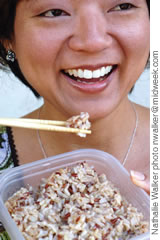The Scoop On Eating White Rice

Friday - February 07, 2007
| Share
 Del.icio.us
Del.icio.us
To get more fiber in your diet,
switch from white to brown
rice
A recent visit to the hospital ended with doctor’s orders to cut down on white rice.
Like I really needed an M.D. to tell me this. I know I eat a lot of rice, about two to three scoops for lunch and dinner daily - that’s up to six scoops a day. But I can’t help it. I grew up on rice. And I love it.
If, however, I care at all about my health, then it’s time to reduce my intake.
“I don’t see white rice as a horrible, evil food, but I would like to see people eat brown rice more frequently,” says Alan Titchenal, assistant professor in human nutrition at the University of Hawaii. “With brown rice they’re going to get more dietary fiber out of it, and there’s a slight increase in the amount of vitamins and minerals.
“Too much of anything could be bad for you. And too much white rice can just throw your diet out of balance, especially if your diet becomes too high in carbohydrates.”
But if you’re like me and just can’t live without rice, don’t worry, there’s still hope for us. The answer is brown rice. Yes, it has a different texture and even a slight change in taste. But it’s better for you.
“Half a cup of medium grain brown rice has about 1.8 grams of fiber where half a cup of medium grain white rice has about .3 grams of fiber, so brown rice has six times the amount of fiber than white rice,” notes Titchenal. “And fiber is important because it helps to keep a healthy intestinal tract. It helps to keep things moving along. And it helps to reduce things like constipation. Also, it may reduce the risk of certain chronic diseases, such as colon cancer and heart disease.”
Too much white rice in your diet could also equate to extra calories that, if not burned off, will increase your body fat level over time. It also could mean that less of your diet is coming from other types of foods.
According to Titchenal, one scoop of cooked medium grain white rice is about 200 calories.
“And someone who eats a whole lot of rice and not a lot of meat could have inadequate iron intake and protein intake,” adds Titchenal. “So it’s really a matter of what does all that rice displace. What foods don’t they eat?”
So how much is too much? That all depends on a person’s calorie needs.
According to the newest United States Department of Agriculture food pyramid, a person who is consuming 2,000 calories a day should get about six-ounce equivalents from the grains group (any food made from wheat, rice, oats, cornmeal, barley or another cereal grain), and at least half of that should be from whole grains (not refined).
That’s about four scoops of rice a day. But remember, white rice is not considered whole grain.
According to the USDA, most Americans consume enough grains, but few are whole grains.
“There’s nothing inherently bad about white rice other than that, like white bread, it has a lot of calories without a lot of nutrients,” says Titchenal. “One good thing is that it’s obviously a good form of carbohydrate energy for the body, especially if you are doing very much exercise. But in terms of other key nutrients, it’s a little bit of various things but not a whole lot of anything. For example, there’s a little bit of magnesium, iron and small amounts of B-vitamins.
“One of the problems for people who rely just on white rice is that if you’re eating white bread, it’s made from enriched white flour, so there’s added vitamins and minerals to the milled wheat flour, but with white rice you rarely have enriched white rice.
“There’s a law that white flour that is going to be used for white bread must be enriched. But we have no such law for rice,” Titchenal says.
The difference between whole grains and refined grains is that refined grains have been milled, a process that removes the bran and germ.
This process creates a finer texture and improves the shelf life to the grains, however, it also removes its dietary fiber, iron and many B vitamins.
If you still can’t get yourself to switch to brown rice, simply mix the two in your rice cooker. You’ll hardly notice a difference in flavor, but your body should feel it.
“If you’re having brown rice at least half of the time, it does make a big difference,” says Titchenal. “You’re more than doubling the dietary fiber content of that rice.
“When it comes to your diet, I always struggle with people keeping in balance. If you’re overdoing the white rice, try to substitute with some brown rice. And if you’re doing just too much rice in general, then you should be cutting down on it and replace it with fruits and vegetables, and what else you’re lacking in your diet. That’s why we have these food guidance tables for people.”
Each person’s calorie needs differ, depending on age, gender and physical activity. For a customized pyramid plan, visit www.mypyramid.gov
E-mail this story | Print this page | Comments (0) | Archive | RSS Comments (0) |
Most Recent Comment(s):













